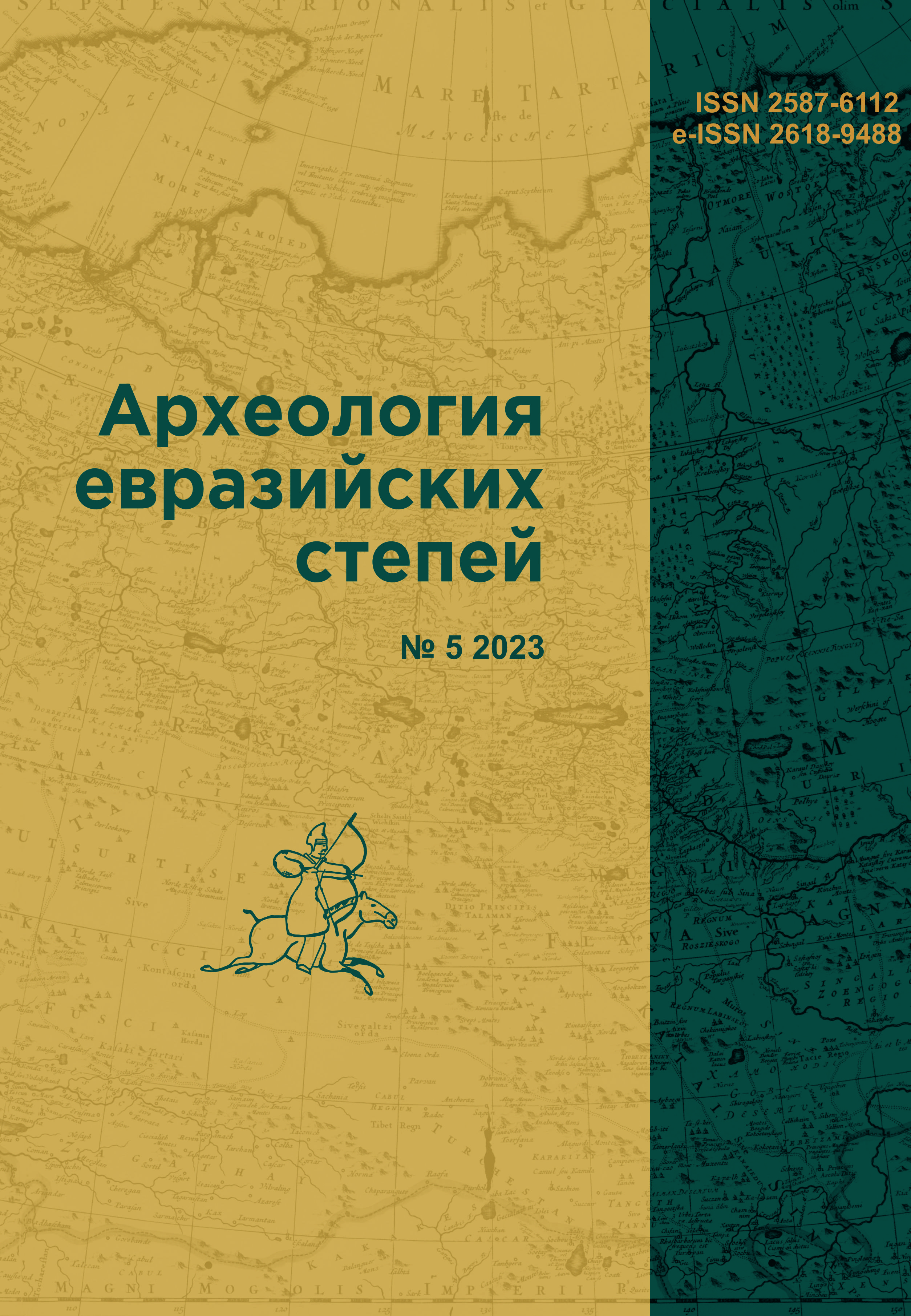Paleodemographic Study of the Annunciation Monastery’s Necropolis in Astrakhan
DOI:
https://doi.org/10.24852/2587-6112.2023.5.268.282Keywords:
archaeology, paleodemography, necropolis, age cohort, average life expectancy, child mortality rate, mortality peakAbstract
As a result of archaeological studies, a large series of anthropological material was obtained, which made it possible to characterize in detail the characteristics of the Russian Astrakhan population in the XVI–XX centuries. A paleodemographic analysis was carried out using materials from the necropolis of the XVI–XIX centuries from the Annunciation Monastery in Astrakhan. The methodology of J.Angel (1969) was used. The total number of individuals was 350. 270 skeletons belonged to adults, 80 – to children. This group was characterized by a rather high average life expectancy (29.3 years), a low percentage of child mortality (22.9%), including in the first year of life. The first peak of mortality occurred in the 0–5 age cohort, the second – at the age of 30–35 years. In general, the authors can ascertain the phenomenon of relative demographic well-being in the study group.
References
Akimovsky, S. Yu. 2023. Otchet ob arkheologicheskikh raskopkakh na territorii Blagoveshchenskogo monastyrya v istoricheskom tsentre goroda Astrakhani v 2022 g. (Report on archaeological excavations on the territory of the Annunciation Monastery in the historical center of Astrakhan in 2022). Astrakhan. Archive of the Institute of Archaeology of the Russian Academy of Sciences (in Russian).
Alekseev, V. P. 1966. Osteometriia. Metodika antropologicheskikh issledovanii (Osteometry. Anthropologic Research Technique). Moscow: “Nauka” Publ. (in Russian).
Alekseev, V. P., Debets, G. F. 1964. Kraniometriia. Metodika antropologicheskikh issledovanii (Craniometry. Anthropologic Research Technique). Moscow: “Nauka” Publ. (in Russian).
Belyaev, L. A. 2011. In Vestnik Pravoslavnogo Svyato-Tihonovskogo gumanitarnogo universiteta. Seriya V. Voprosy` istorii i teorii khristianskogo iskusstva (St. Tikhon's University Review. Series V. Issues of history and theory of Christian art) 2(5), 72–84 (in Russian).
Bogatenkov, D. V. 2003. In Alekseeva, T. I., Bogatenkov, D. V., Lebedinskaia, G. V. Vlakhi. Antropo-ekologicheskoe issledovanie (po materialam srednevekovogo nekropolia Mistikhali) (The Vlakhs. Anthropological – Ecological Research (on Materials from the Medieval Necropolis of Mistikhaly). Moscow: “Nauchnyi mir” Publ., 19–49 (in Russian).
Borutskaya, S. B., Vasilyev, S. V. 2015. In Chernykh, I. N. (ed.). Tverskoi arkheologicheskii sbornik (Tver Archaeological Collection of Papers) 10. Tver: Tver State United Museum, 318–325 (in Russian).
Borutskaya, S. B., Vasilyev, S. V. 2021. In Arkheologiia Evraziiskikh stepei (Archaeology of Eurasian Steppes) 3, 307–320 (in Russian).
Borutskaya, S. B., Kharlamova, N. V., Rudnikov, S. A., Chernykh, I. N. 2021. In Voprosy antropologii (Issues of Anthropology) 2, 311–329 (in Russian).
Borutskaya, S. B., Vasilyev, S. V., Gazimzyanov, I. R., Koshelev, A. I. 2021. In Aktual'nye voprosy antropologii (Topical issues of anthropology) (16), 28–38 (in Russian).
Vasilyev, S. V., Borutskaya, S. B. 2007. In Bessudnov, A. N. (ed.). Verkhnedonskoi arkheologicheskii sbornik (Upper Don Archaeological Collected Articles) 3. Lipetsk: Lipetsk State Pedagogical University, 289–312 (in Russian).
Vasilyev, S. V., Borutskaya, S. B., Zemtsov, G. L. 2020. In Stratum Plus (6), 335–346 (in Russian).
Vasilyev, S. V., Borutskaya, S. B. 2004. In Vasilyev, S. V. (ed). Rasy i narody (Races and peoples) 30. Moscow: Institute of Ethnology and Anthropology named after N.N. Miklouho-Maklay, Russian Academy of Sciences, 249–267 (in Russian).
Dobriak, V. I. 1960. Sudebno-meditsinskaia ekspertiza skeletirovannogo trupa (Forensic Medical Examination of Skeletonized Cadaver). Kiev: State Medical Publisher House of the Ukrainian SSR (in Russian).
Igumen Iosif (Maryan). 2002. Astrakhan'. Khramy i monastyri (Astrakhan. Churches and monasteries. Astrakhan). Astrakhan: “Novaya Liniia” Publ. (in Russian).
Nikitiuk, B. A. 1960. In Voprosy antropologii (Issues of Anthropology) 2. Moscow: Moscow State University, 115–121 (in Russian).
Nikitiuk, B. A. 1960. In Voprosy antropologii (Issues of Anthropology) 3. Moscow: Moscow State University, 118–129 (in Russian).
Pashkova, V. I. 1963. Ocherki sudebno-meditsinskoi osteologii (Essays on Forensic Osteology). Moscow: “Medgiz” Publ. (in Russian).
Rubtsova, S. S. 2017. Gradostroitel'naya evolyutsiya Astrakhani (Urban development of Astrakhan). Ulyanovsk: Ulyanovsk Printing House (in Russian).
Rudenko, E. I. 1973. Zagadki bugrov Bjera (Secrets of Baer knolls). Volgograd: “Nizh.-Volzh. Knizhnoe izdatelsvo” Publ. (in Russian).
Angel, J. L. 1969. In American Journal of Physical Anthropology (30), 427–438.
STANDARDS. 1994. For data collection from human skeletal remains. Indianapolis, 44, 1–35.
Ubelaker, D. H. 1978. Human Skeletal Remains: Excavation, Analysis, Interpretation. Chicago: Adline publishing company.

Additional Files
Published
How to Cite
Issue
Section
License
Copyright (c) 2023 S.B. Borutskaya, S.V. Vasilyev, D.V. Vasilyev

This work is licensed under a Creative Commons Attribution-NonCommercial 4.0 International License.







